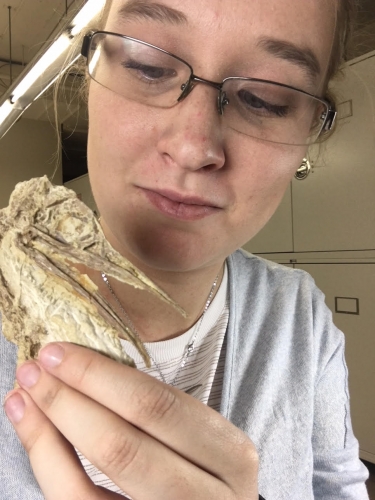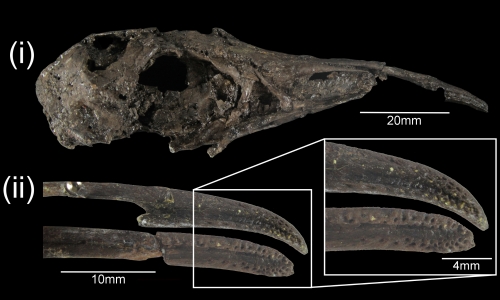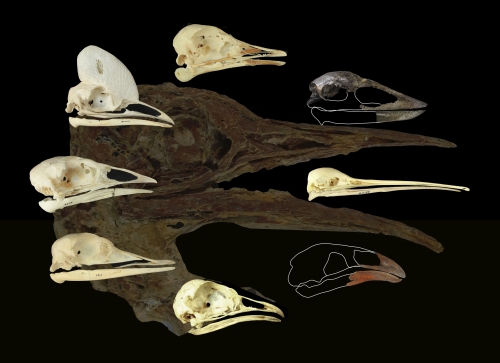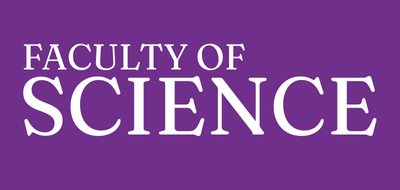Sensing good vibrations: a remarkable sensory organ in the beaks of ancient fossil birds


Ornithologist & PhD candidate Carla du Toit (lead author of the paper) holds a fossil specimen of a lithornithid, Pseudocrypturus cercanaxius, to give an indication of the size of these birds. Specimen housed in and access provided by the Smithsonian National Museum of Natural History (photo credit Carla du Toit)
Newly published research by an all-women team from the University of Cape Town shows how one of the most ancient groups of birds (from the time of the dinosaurs) was able to detect minute mechanical vibrations in the soil using their beaks. Birds that feed on small prey items (such as worms, molluscs and small fish) buried in mud or under water often do so blindly – without the aid of visual cues to help them locate their prey. They capture their prey by probing their long beaks into the substrate and pulling out the prey, a
feeding method known as probe-foraging. Some probe-foraging birds (such as the iconic Hadeda ibis in southern Africa and kiwi from New Zealand) have this “sixth sense” called ‘remote-touch’, which enables them to locate their buried prey before it comes into direct contact with their beaks. Remote-touch refers to their ability to detect minute vibrations from their prey items in the substrate, using a specialized organ at the tips of their beaks. This organ is found in three families of living probe-foraging birds: ibises, kiwi and sandpiper-like shorebirds. This billtip organ consists of densely clustered mechanoreceptor cells embedded in pits in the bones of
the birds’ beaks. Intriguingly, a structurally-similar, but functionally mysterious, bill-tip organ occurs in ostriches, emus and their relatives – the paleognaths, an ancient group of birds that also contains the remote-touch probers, the kiwi. This study set out to determine why such an organ was found in all the paleognaths (even those that do not probe-forage), and to try and investigate when this remarkable sense developed among birds.

Phylogeny/family tree of paleognathous birds, showing their beak shapes and the occurance ofthe remote-touch bill-tip organs (image credit Carla du Toit)
“What’s been really exciting to palaeobiologists studying the evolution of birds, aside from remote-touch being a remarkable sensory adaptation that has cropped up multiple times in the avian record, is that this bill-tip organ has the potential to be preserved in the fossil record, as it appears to potentially be characterized by large numbers of bony pits on the surfaces of the beak bones,” says lead author, Carla du Toit. “But before we could look at fossil birds to try and understand the evolution of this organ and explain its presence in the paleognaths, we first needed to quantify whether or not it could be reliably differentiated based on the distribution and
number of these bony beak pits in the absence of soft tissues (which do not preserve well at all in the fossil record in comparison to bones).” Through a review of soft tissue histology of bird beaks as well as a very large dataset comparing the beak bones of living birds across all known groups and most families from museum collections across the world, the researchers found that the remote-touch bill-tip organ could be differentiated from all other beak types in the absence of soft tissues, based both on the pitting
pattern and beak shape data.

Fossil beaks of two specimens of a lithornithid from North America, Lithornis promiscuus, showing the beak shape (i) and the high degree of pitting preserved on the surface of the beak bones. Specimens housed in and access provided by the Smithsonian National Museum of Natural History (image credit du Toit et al. 2020)
“The simple presence/absence of pitting on beak bones is not enough to infer the existence of such an organ in a fossil specimen, as has been erroneously stated in some previous studies,” says du Toit. “All birds have some pits/foramina on their beak bones, so it’s really a threshold of pitting that has to be crossed, in combination with data on beak shape, that’s required to analyze the remote-touch bill-tip organ in fossil birds. And that couldn’t be done without having a reliable dataset of extant birds to compare them to, so we set out to create one that will hopefully be of use to other scientists studying fossil birds.”

The scientists hypothesized that the bill-tip organs found in all living paleognaths, even those that do not probe in the ground for food, might be a vestigial organ remaining from their most recent common ancestor. Luckily, exquisitely preserved beaks of some of the most basal paleognaths, the lithornithids, have been found in North America and Europe. These small (roughly chicken-sized) birds with relatively long beaks and legs are believed to have co-existed with dinosaurs in the Cretaceous period before the extinction event that killed-off all non-avian dinosaurs. This study shows that some if not all the wetland-dwelling lithornithids were likely able to use remote-touch to locate buried prey, in much the same way that modern day ibises and kiwi do. This suggests that modern paleognaths retained the structural components of the ancestral bill-tip organ even though it became functionally redundant, much like the hind limb bones of whales or pythons.
“We’ve been puzzled by the bill-tip organs of ostriches and emus, ever since they were first described by South African researchers about 5 years ago. We knew what this kind of beak was for in probe-foraging birds like kiwis, which are also paleognaths, but it didn’t make sense that these structures were present in their giant non-probing relatives as well, especially as ostrich and emu brains are not wired to deal with the kind of tactile information a bill-tip organ provides. Discovering that the earliest known paleognaths – the lithornithids – were thought to be probeforaging wetland birds, and that there were beautifully preserved fossils available, was really a
lightbulb moment for us” says Dr. Susan Cunningham, senior author and avian sensory ecology specialist. These findings suggest that remote-touch evolved very early in modern birds, perhaps from snout tactile specializations of their non-avian dinosaur ancestors. Previous research on some non-avian meat-eating dinosaurs (that are the ancestors of birds) has shown that several species had some type of tactile specialization on their jaw bones, which may have given them some sensitivity to various stimuli. As some of these dinosaurs were very large compared to modern birds (for example, the 7.5m long & over 2m tall Neovenator salerii) they were certainly not probing in the ground for worms like the birds do, but may have hunted in opaque waters for fish and large reptiles, and used tactile receptors in their jaws to sense the vibrations underwater, similarly to the way modern crocodiles and alligators hunt. This facial sensitivity could then have given rise to the highly specialized bill-tip organ we see today in ibises and kiwi, and which our study has shown evolved millions of years ago in some of the most ancient birds known in the fossil record.

A modern species of remote-touch probing bird: a Hadeda ibis probes for food using remotetouch on a beach in South Africa, much in the same way the lithornithids would have done millions of years ago (photo credit Peter Ryan)
“This is such an incredibly cool study! We’ve been able to show that the Mesozoic ancestor of ratites (such as, ostriches, rhea, and emu) was a probe-feeding bird like modern ibises and kiwi. Furthermore, our finding suggests that the remote-sense organ in the beaks of birds most likely originated from the sensitive snouts of their dinosaurian ancestors” says co-author and leading dinosaur palaeontologist, Prof. Anusuya Chinsamy-Turan.
The scientists involved in this study believe that this research will significantly contribute to understanding the evolution of sensory and neuroanatomical systems in birds and their dinosaurian relatives. This work will further drive our understanding of both the ancient ancestors of birds as well as living probe-foraging birds, among which are some of the most threatened species of birds.
Paper: du Toit CJ, Chinsamy A, Cunningham SJ. 2020 Cretaceous origins of the vibrotactile bill-tip organ in birds. Proceedings of the Royal Society B 287: 20202322. https://doi.org/10.1098/rspb.2020.2322
